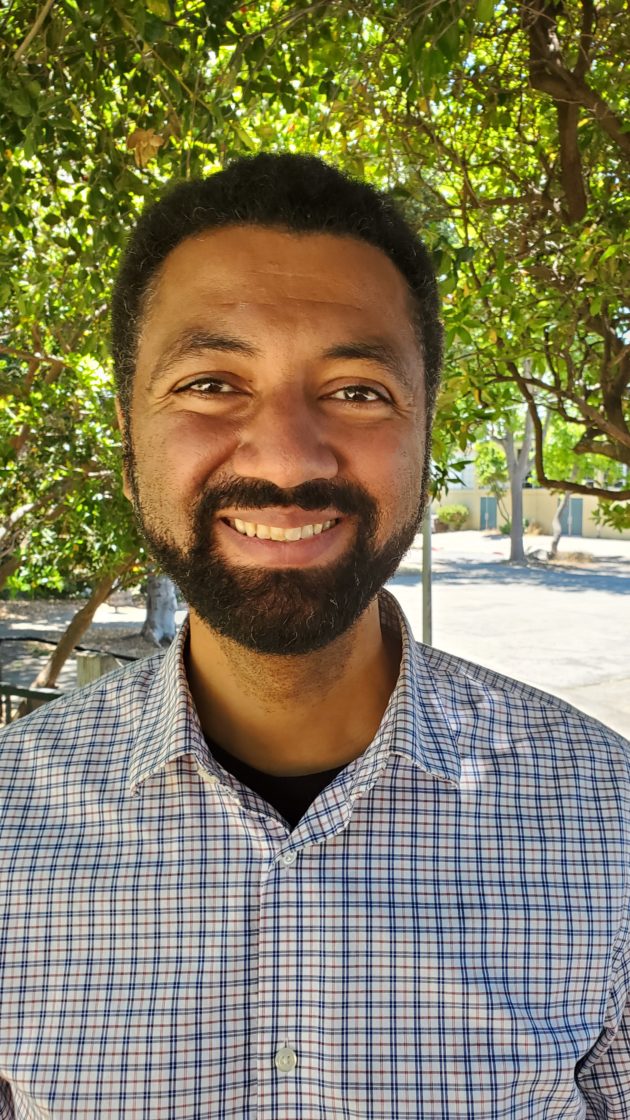 Alpha N’Diaye first came to Berkeley Lab as a postdoc, but his interest in Berkeley was piqued far earlier. Find out what inspired teenage Alpha, and what keeps him here to this day.
Alpha N’Diaye first came to Berkeley Lab as a postdoc, but his interest in Berkeley was piqued far earlier. Find out what inspired teenage Alpha, and what keeps him here to this day.
What path did you take to become a research scientist at the ALS?
I worked in surface science in Germany, where I did my undergrad and grad studies. After my PhD, I thought that it would be nice to live abroad for a while, and the US, which was not too exotic, but also not too similar, seemed to be the right kind of mix. California is a very welcoming environment. Actually, coming to Berkeley was something I toyed with in my mind when I was a teenager, and I forgot about it for many years. Once I had selected Berkeley, I remembered that I had really enjoyed a book written by a postdoc from Lawrence Berkeley Lab, The Cuckoo’s Egg by Clifford Stoll. So in that sense, that teenage dream has fulfilled itself.
I had come to the National Center for Electron Microscopy (NCEM) as a postdoc, and we intended to stay for one or two years, but it’s easy to get stuck in the Bay Area. I was looking for a job and found the ALS intriguing. I like working at the Lab—the environment, the people, and the spirit. I also very much like the collaborative spirit at user facilities and the opportunity to work and have an impact on diverse projects.
What kinds of projects do you work on?
What I really like is being able to go broad and deep at the same time. One day, you can work on new magnetic materials, which might be used in hard drives. The next day, you look at some magnetic molecules, which maybe 10 or 15 years down the road make those very hard drives obsolete. With the same technique and approach, you can look at meteorites as old as the planets, or archaeological rocks to understand how an ancient fort was built.
There’s also the opportunity to take on leadership roles and help define the future of the Lab and the facility. I think the future really needs to emphasize working together on common goals creatively. Our tasks are so big that we can’t do them alone, and we can reach so much further if we work together. We’re all surrounded by people who have all these unique skills and are really good at what they do.
I’m chair of the Quantum Materials Research and Discovery Thrust Area, and it’s one way I am enjoying bringing people together. We’ve had some funding successes, because the whole team supports the development of each and every proposal of its members.
What are quantum materials, and how do you study them?
Quantum materials are materials in which the quantum nature of their electrons becomes apparent in their macroscopic properties. Soft x-rays talk to the electrons, and by asking those electrons specific questions, we try to find out if they are subject to those quantum effects. The answer comes out in the form of another x-ray or another electron, but of course, in order to interpret that we have to understand our instrumentation and have to understand the physics behind that.
How do you work on inclusion, diversity, equity, and accountability (IDEA) efforts?
It’s very important to understand what things we have been doing for a long time that are maybe not consistent with our ethical standards. The way everybody addresses that is also a personal choice; what is impactful for each and every one of us might be quite different. For me, it starts with taking the time to relate to everybody as a person. Then there are other things I do; for instance, I think about how to balance invitations to the seminar series or how to staff the committees I’m in charge of.
What do you like to do in your free time?
I like to connect to nature and connect to culture. We like to go camping. We visit the Yuba River every year, and I even found a little bit of gold there once.
I’ve never lived in a place before where culture and nature are so close to one another. Within 15 minutes, you’re at a place where mountain lions roam free, and if you go in the other direction, you can be at the de Young Museum or at the Museum of Modern Art. You can look at the works of people who try to understand the world like we do, just through art, not through science. It’s important, because as scientists we can describe a lot of things, but we cannot talk about what makes us human. That, art can do.